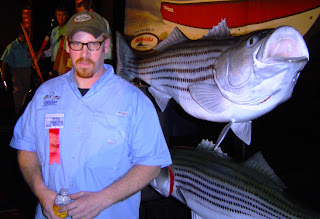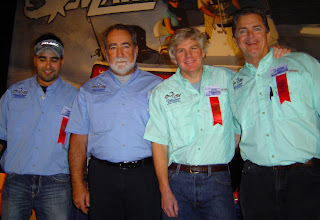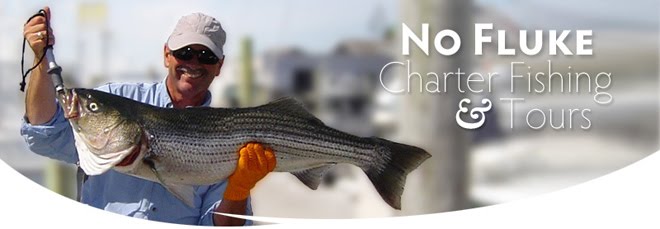 Greg Myerson of Westport, CT with the world record 81.8 pound striped bass he caught this summer. Greg was a speaker at the Saltwater Sportsman National Seminar Series held this past Saturday at Mohegan Sun.
Greg Myerson of Westport, CT with the world record 81.8 pound striped bass he caught this summer. Greg was a speaker at the Saltwater Sportsman National Seminar Series held this past Saturday at Mohegan Sun.  (Left to right) Rhode Island Captains Louis DeFusco and John Rainone shared the stage with Saltwater Sportsman National Seminar Series co-host Tom Richardson and host George Poveromo. George is host of the George Poveromo’s World of Saltwater Fishing television program.
(Left to right) Rhode Island Captains Louis DeFusco and John Rainone shared the stage with Saltwater Sportsman National Seminar Series co-host Tom Richardson and host George Poveromo. George is host of the George Poveromo’s World of Saltwater Fishing television program. Local captains share stage at 25th Anniversary Saltwater Sportsman Seminar
The 25th Anniversary Tour of Saltwater Sportsman magazine’s national seminar series got off to a great start Saturday at Mohegan Sun in Uncasville, CT with approximately 900 anglers in attendance.
This was the first seminar in a series of eight that will travel the east coast. The series is hosted by George Poveromo of George Poveromo’s World of Saltwater Fishing television program and editor-at-large for Salt Water Sportsman magazine, and Tom Richardson, noted authority on fishing the coastal waters of New England and a prominent fishing writer and editor.
George and Tom shared the stage with eight local captains, two of them from Rhode Island. Captain John Rainone, past president of the Rhode Island Party & Charter Boat Association and a distinguished Point Judith, Rhode Island based charter captain from the vessel “L’il Toot”. The second Rhode Islander sharing the docket was Captain Louis DeFusco of West Warwick, RI who runs the charter vessel Hot Reels out of Point Judith (Captain DeFusco captured the Rhode Island swordfish record this summer with a 434 pound fish).
One of the highlights of the seminar was meeting and listening to Greg Myerson of Westport, Connecticut. Greg caught the 81.8 world record striped bass this summer using a three-way swivel with a large eel around a twelve foot boulder, one of his favorite big bass fishing spots. In an interview (visit www.noflukefishing.blogspot.com for the video), Greg said, “I use the largest eels I can get because the big fish are going to eat the big eels… and you have to be stealth. No noise on the boat.” Greg said, “The best time to fish for trophy bass is at slack tide. The big fish are lazy. They are not interested in chasing bait in a lot of current, but rather wait until the water is still and they can hear and feel the vibrations of lobsters. Bass are near-sighted so it’s all about listing and feeling vibration to find their prey.”
Greg continued to say, “When I was younger fishing with friends we would have bass catching contests and if there were four guys on the boat, all presenting eels to the bass in the same spot what is going to get them to take my eel versus the others. I found that trying to mimic the sound of a lobster worked well. Once attracted to the area my bait they would see the eel and take it.”
Greg said that he has invented a new fishing tackle device that attaches to your rig that is designed to mimic the sound of a lobster. He will show the device at the Springfield Sportsmen’s Show in February this year (visit Greg’s website at www.worldrecordstriper.com).
Each captain and fishing expert shared their favorite way to catch a variety of species. When asked about his favorite way to catch striped bass seminar host George Poveromo said, “I like top water lures. There is nothing like when a bass hits the plug.” (visit www.noflukefishing.blogspot.com for a video interview).
Here are some highlights of what other fishing experts had to say about tuna and striped bass fishing (fluke and tautog tips to follow in future columns).
Tuna
When fishing for tuna, watch the water for birds feeding, oil slicks from past blitzes on bait in the area, whales feeding, etc. The answer to the question “where are the fish” is usually right in front of you. You have to learn how to read the water to find them.
When on the troll floral carbon leaders “give you strength plus a thinner, less visible presentation.” said seminar host George Poveromo.
Striped bass
The very first bass usually appear in April when the water hits 50 degrees off coastal shores, Narragansett Bay experts say they find the water a bit warmer (to 54 degrees) before they see the first spring bass
Most early spring bass are caught in shallow water, three to twelve feet
Favorite ways to catch bass as related by experts included fishing with a three way swivel with eels (this method is world record holder Greg Myerson’s favorite method); top water plugs and swimming lures; a variety of soft plastic baits; and fishing with menhaden chucks or whole live fish.
A slow retrieve works best in the spring, faster retrieves when the water is warmer
Diamond jigs are often used in the spring too, three to four once jigs
Summer fishing for big bass is usually done at night, water typically 70 degrees, fish structure (reefs) in 28 to 44 feet of water starting at the high point of the reef; Captain Rick Mola of Norwalk, CT said, “One of the tactics we use in the summer is fishing with parachute jigs. I troll at 2.5 to 3 knots and tell customers to envision they are sweeping the floor.” rather than using hard jerking motions.
Captain Mola also said, “We use menhaden often in the spring, either live or in chuck form, generally in low water.” (visit www.noflukefishing.blogspot.com for a video interview with Captain Mola on fishing with menhaden).
Now is the time for your input on regulations at Fisheries Council meetings
The Rhode Island Marine Fisheries Council, their advisory panels and a major public hearing will be convening this month and next to determine what fishing regulations will be recommended for 2012. Anglers are urged to attend these meetings as this is the opportunity we have to impact fishing policy and regulation here in Rhode Island. The meeting schedule form the Department of Environmental Management Marine Fisheries website is as follows: http://www.dem.ri.gov/topics/mftopics.htm for details, meeting times and locations.
January 11, Shellfish Advisory Panel
January 17, Winter Flounder Advisor Panel
January 17, Striped Bass Advisory Panel
February 22, Public Hearing for input on policy/regulations for many species. Agenda items to include proposed changes to the Management Plans of the following:
Recreational Summer Flounder
Commercial Winter Flounder
Recreational and Commercial Tautog
Recreational Scup
Recreational Black Sea Bass
Commercial Monkfish
Commercial Cod
Commercial General Category Striped Bass
Recreational Striped Bass
Commercial Floating Fish Trap Striped Bass
Narragansett Bay Menhaden
Other agenda items include:
Proposal to amend the soft-shell clam regulations to increase the minimum legal size statewide;
Proposal to establish Conimicut Point Shellfish Management Area;
Proposal to establish a daily soft-shell clam possession limit for Conimicut Point Shellfish Management Area; and
Proposal to amend the soft-shell clam regulations for non-shellfish management areas by reducing the daily possession limit statewide
Where’s the bite
Cod fishing is improving but with the water so warm the dog fish are plentiful. Dave Garzoli reports on the RISAA blog , “ I managed five keepers and a few toss backs (Sunday on the Francis Fleet) … A guy at the pulpit who was able to toss his jig and work it into the drift did well and managed a limit. Biggest fish that I saw was pushing 15 pounds. The grounds are absolutely loaded with small dogs. Most fished jigs and still had doggie issues. The guys dunking clams caught a few cod but most were busy messing with the dog fish.” Leo Arsenault said, “I went out on Saturday on the Lady Francis and experienced the same as you, for every small cod caught seven dog fish would be caught.”


